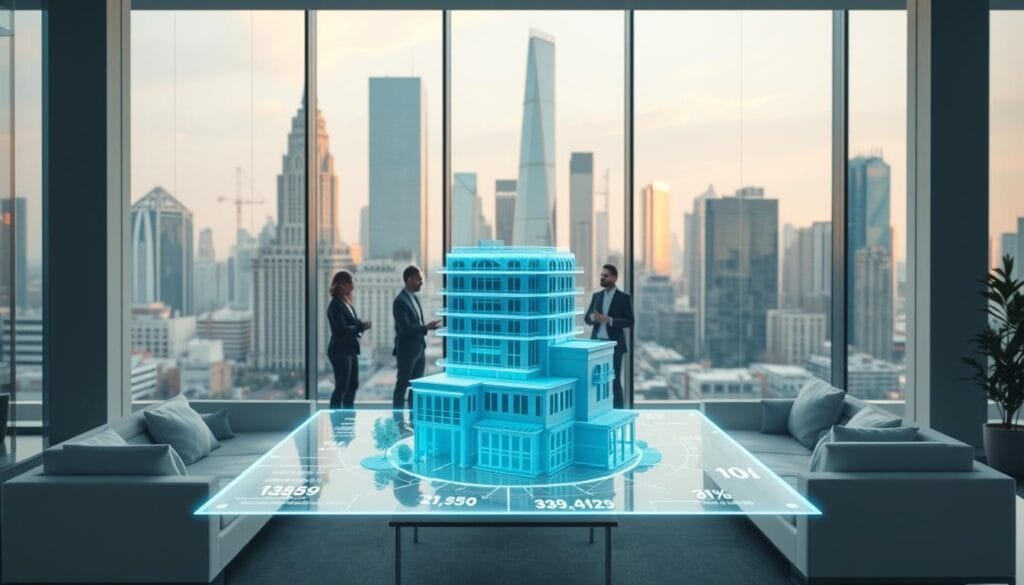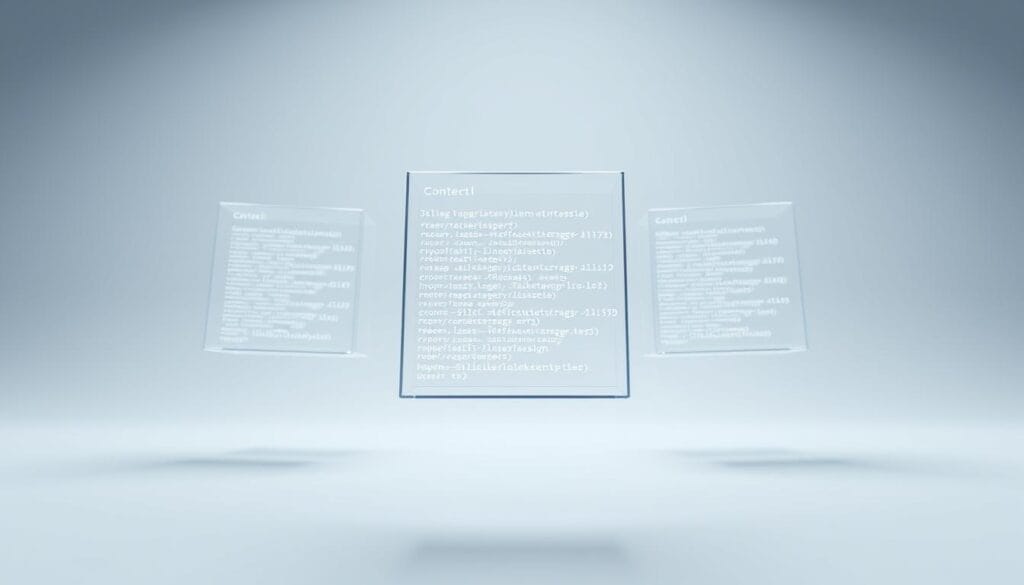By 2025, blockchain technology could unlock $1.4 trillion in global real estate liquidity through fractional ownership models. This seismic shift stems from digitizing property assets into tradeable tokens, enabling investors to buy shares as small as $100 in high-value commercial or residential spaces.
Traditional barriers like steep capital requirements and geographic limitations are dissolving. Blockchain’s decentralized ledger system ensures transparent transactions while reducing administrative costs by up to 30%. Regulatory frameworks, such as Europe’s MiCA legislation, now provide clearer guidelines for secure token exchanges.
Emerging platforms allow investors to diversify portfolios with previously inaccessible markets. A single skyscraper or luxury villa can be divided into thousands of digital tokens, democratizing access to wealth-building opportunities. Analysts predict this innovation will attract 15 million new participants to real estate markets by 2026.
Key Takeaways
- Blockchain technology enables fractional ownership of high-value properties through digital tokens
- Regulatory advancements like MiCA are creating safer frameworks for tokenized asset trading
- Minimum investment thresholds could drop below $100 by mid-2025
- Global market accessibility reduces reliance on local property conditions
- Automated smart contracts streamline transactions and ownership verification
Introduction to Tokenized Real Estate Investing

Traditional property markets are evolving into digital ecosystems through asset digitization. This shift replaces paper deeds with blockchain-secured tokens, enabling partial stakes in high-value buildings or land parcels. Fractional ownership models now let multiple parties share profits from a single asset, a concept once limited to institutional players.
Overview of the Transformation in Real Estate
Legacy systems required six-figure sums and local expertise to acquire physical properties. Modern platforms convert brick-and-mortar assets into divisible digital units.
Blockchain’s immutable records reduce fraud risks while accelerating deal timelines. A 2024 industry report notes:
“Tokenization slashes closing periods from 45 days to 72 hours through automated compliance checks.”
Key Drivers and Market Dynamics
Three forces propel this change: demand for liquid alternatives, regulatory clarity, and advancing tech. Global investor participation jumped 210% since 2022 as platforms standardized token issuance.
Emerging markets now attract smaller capital commitments, with minimums falling below $500 in some regions. Cross-border transactions surged 38% last year, fueled by real-time settlement features. These shifts create a $800 billion secondary market for digital property shares by 2026 estimates.
Exploring tokenized real estate investments 2025

The digitization of physical assets is reshaping how individuals engage with property markets. Blockchain-powered platforms now enable participation in premium assets through divisible shares, breaking down traditional financial barriers.
Defining the Main Keyword
Tokenized real estate refers to converting property rights into blockchain-based digital shares. These tokens represent partial stakes in physical or commercial buildings, governed by smart contracts. Fractional ownership allows multiple stakeholders to collectively benefit from asset appreciation and rental income without full acquisition costs.
Relevance for Modern Investors
This model addresses three critical needs: reduced upfront capital, diversified portfolios, and instant liquidity. A 2024 JPMorgan study revealed tokenized properties achieve 40% faster resale than traditional listings. Platforms now enable $250 stakes in Manhattan high-rises or Tokyo office complexes.
One Miami Beach condominium project raised $12 million through 4,800 digital tokens last quarter. Investors received automated payouts via blockchain escrow systems. As regulatory frameworks stabilize, analysts project 22% annual growth for fractionalized market shares through 2028.
“Tokenization turns illiquid assets into tradeable securities, creating unprecedented flexibility for wealth generation.”
The Advantages of Real Estate Tokenization

Market dynamics are undergoing radical transformation through digital asset division. Tokenization reshapes how properties are bought, managed, and traded by converting physical assets into divisible blockchain-based shares. This evolution addresses longstanding inefficiencies while expanding opportunities for diverse participants.
Increased Liquidity and Lower Barriers
Fractional ownership models dissolve the $50,000+ entry costs typical in traditional real estate. A single commercial tower can now host 10,000 token holders, each with stakes as low as $250. Platforms report average minimums dropping 73% since 2023, attracting 850,000 new investors last year alone.
Blockchain’s divisibility enables instant secondary trading through decentralized exchanges. A Dubai hotel project saw 92% faster resales compared to conventional methods. “Liquidity transforms property from a stagnant asset into a flexible wealth-building tool,” notes a Goldman Sachs fintech analysis.
Enhanced Transaction Efficiency
Smart contracts automate title transfers, compliance checks, and payment distributions. This slashes administrative costs by 40% and processing times from weeks to hours. A Berlin office complex recently closed a $4.2 million deal in 18 minutes using automated ledger systems.
Investors gain exposure to global markets without local brokers or paperwork. Platforms like real estate trusts enable cross-border participation through unified digital interfaces. These advancements could add $300 billion to global property market capitalization by 2026.
Navigating Regulatory and Legal Considerations

Global property markets face evolving legal frameworks as blockchain reshapes asset management. Regulators now prioritize balancing innovation with investor protection, creating structured pathways for digital ownership models. This shift addresses critical risks like fraud and jurisdictional conflicts while fostering cross-border participation.
Understanding MiCA and Global Regulatory Trends
The EU’s Markets in Crypto-Assets (MiCA) legislation standardizes rules for digital tokens across 27 nations. It mandates capital reserves for issuers and real-time transaction reporting, reducing systemic barriers. Similar frameworks in Singapore and Dubai now require escrow protections for property-linked tokens.
Legal expert Clara Mertens notes:
“MiCA’s custody rules prevent platform insolvencies from eroding investor assets—a game-changer for market confidence.”
Insights from Luxembourg’s Blockchain Law
Luxembourg’s 2024 reforms permit blockchain-recorded property titles with equal legal standing to traditional deeds. Its automated compliance protocols validate ownership transfers in under 90 seconds. This approach cuts administrative costs by 57% while enhancing transparency.
Despite progress, challenges persist. Cross-border tax policies remain fragmented, and 42% of platforms lack standardized security audits. However, nations adopting clear guidelines report 68% faster adoption rates, signaling how regulatory clarity drives mainstream acceptance.
Technological Innovations Driving Tokenization

Advanced systems are redefining how properties are managed and traded globally. At the core of this revolution lies blockchain infrastructure paired with intelligent automation tools, creating new standards for speed and reliability in asset transactions.
Blockchain and Smart Contracts as Game Changers
Distributed ledger technology ensures tamper-proof records for every digital token transaction. Smart contracts execute automatically when preset conditions meet, cutting manual process steps by 80%. A Tokyo residential project recently used this system to distribute rental income to 1,200 token holders in under three minutes.
These tools eliminate intermediaries like notaries and escrow agents. Platforms handling $4.3 billion in assets report 99.6% audit accuracy since adopting blockchain-based title registries. This transparency builds trust while reducing disputes over ownership rights.
Emerging Role of AI in Real Estate
Artificial intelligence optimizes property valuations and tenant screening. Machine learning models analyze market trends to suggest optimal trading strategies for digital shares. One Chicago platform uses predictive algorithms to alert investors about undervalued commercial properties.
AI chatbots now handle 73% of investor inquiries about tokenized asset performance. Automated systems also monitor regulatory changes across 14 jurisdictions, ensuring compliance during cross-border transactions. This synergy between blockchain and AI unlocks potential for near-instant global deals.
“Combining these technologies reduces operational friction, letting markets focus on value creation instead of paperwork.”
Benefits of Fractional Ownership and Market Accessibility

Fractional ownership models are dismantling financial gatekeepers in property markets. By splitting high-value assets into affordable shares, these systems empower individuals previously excluded from premium opportunities. Global participation now hinges on digital access rather than geographic proximity or wealth thresholds.
Democratizing Access for a Broader Investor Base
Minimum commitments below $250 let retail participants compete with institutional buyers. A 2024 Federal Reserve study shows 72% of new entrants earn under $100k annually—a demographic rarely seen in traditional real asset markets. Platforms using tokenizing assets report 89% faster onboarding than conventional brokerage systems.
Secondary markets enable instant trading of property shares through mobile apps. This liquidity contrasts sharply with the 6-18 month cycles typical of physical sales. “You’re no longer betting on one neighborhood’s growth—your capital works across continents,” observes fintech analyst Rachel Lin.
Diversification becomes achievable without massive reserves. A teacher in Ohio can simultaneously hold stakes in a Berlin apartment complex and a Singapore retail hub. These shifts explain why 34% of millennials now include fractional shares in their retirement plans, per Morgan Stanley data.
Institutional players benefit too. Automated platforms slash management costs by 60% while expanding their investor networks. This symbiotic growth fuels predictions that fractional models will dominate 40% of global property transactions by 2027.
Emerging Platforms and Investor Trends

Digital property markets are witnessing a surge of specialized platforms reshaping ownership structures. Leading services like RealT demonstrate how blockchain-enabled systems attract diverse participants, from retail enthusiasts to institutional funds.
Case Studies: RealT and Other Innovators
RealT’s platform now hosts 18,000+ investors managing $240 million in residential and commercial properties. Their Detroit apartment portfolio delivered 9.2% annual returns since 2023, outperforming traditional real estate investment trusts by 34%. Competitors like SolidBlock and Propy streamline cross-border transactions, cutting settlement times from weeks to 48 hours.
“Our users span 76 countries—a feat impossible with physical deeds,” notes RealT’s CEO. “Blockchain’s standardization allows seamless participation in Miami villas or Paris storefronts.”
Market Statistics and Future Growth Indicators
Secondary trading volumes for property tokens reached $4.1 billion in Q2 2024, a 290% year-over-year increase. Analysts at Deloitte predict 55% annual growth through 2027 as industry standards mature.
Three trends dominate:
- Automated management tools reducing operational costs by 62%
- Institutional adoption rising to 28% of total transactions
- Regulatory approvals accelerating in 14 major economies
These shifts suggest digital platforms could handle 40% of global property deals by 2026, unlocking $2.1 trillion in previously illiquid assets.
Blockchain Security and Transparency in Transactions
Immutable ledgers form the backbone of trust in digital property markets. Blockchain’s cryptographic architecture creates an unalterable record of ownership transfers, rental agreements, and profit distributions. Every transaction receives a unique timestamped signature, visible to all network participants but editable by none.
Ensuring Data Integrity and Fraud Prevention
Decentralized validation protocols eliminate single points of failure. Multiple nodes cross-verify each asset transfer, flagging discrepancies in real time. A 2024 MIT study found blockchain-based systems reduce property fraud attempts by 83% compared to traditional databases.
Smart contracts automate compliance checks during deals, ensuring adherence to local regulations. This process removes human error from title transfers and payment allocations. Platforms using these tools report 99.98% accuracy in ownership records since 2023.
“You can’t forge a blockchain entry without controlling 51% of the network—a near-impossible feat in established systems,” explains cybersecurity expert Dr. Elena Torres.
Robust encryption protects digital wallets and transaction histories. Multi-signature approvals add layers of security, requiring both investor and platform authorization for major actions. These measures mitigate risks like unauthorized asset sales or duplicate token issuance.
Transparency remains equally critical. Public ledgers let investors audit cash flows and occupancy rates for shared properties. This visibility fuels confidence in decentralized lending platforms, where 67% of users cite verifiable data as their primary trust factor.
Future Predictions and Market Impact
Analysts project a seismic shift in asset management through decentralized platforms. By 2030, tokenized property markets could surpass $3.8 trillion in value as institutional capital floods into blockchain-based systems. This growth trajectory stems from younger investors prioritizing fractional ownership—43% of Gen Z now allocate over 15% of portfolios to digital assets.
Predicted Growth and Market Cap Trends
Secondary trading volumes for property tokens are expected to grow 300% annually through 2028. A recent Deloitte study forecasts 55 million global participants by 2027, with Asia-Pacific regions driving 62% of new market expansion. Emerging platforms enable diversification across alternative investment strategies, reducing reliance on volatile stock markets.
Potential Risks and Barriers to Adoption
Despite high potential, fragmented regulations across 120 jurisdictions create compliance hurdles. Cybersecurity threats targeting digital wallets increased 210% in 2024, requiring advanced encryption protocols. Industry expert Mark Sullivan warns:
“Interoperability issues between blockchain networks could delay $700 billion in projected adoption by 2026 unless standards emerge.”
Technological scalability remains critical—current systems handle 4,000 transactions/second, but demand will require 25,000+ by 2027. These barriers highlight the need for coordinated global frameworks to unlock the sector’s full value.
Conclusion
The digitization of property markets marks a pivotal shift in global finance, blending technological innovation with evolving regulations. This model dissolves traditional barriers through fractional ownership, granting unprecedented access to high-value assets while lowering capital requirements. Enhanced liquidity and automated compliance emerge as foundational advantages, supported by platforms enabling cross-border participation.
Emerging regulatory frameworks and cybersecurity protocols remain critical priorities. While MiCA and Luxembourg’s reforms set benchmarks, fragmented policies across jurisdictions require ongoing harmonization. Innovative platforms demonstrate tangible success—streamlining transactions and diversifying portfolios—yet demand robust safeguards against digital vulnerabilities.
For forward-thinking professionals, real estate tokenization presents a dual proposition: revolutionary opportunities tempered by complex challenges. Continuous tech development and adaptive governance will determine its trajectory. Those prepared to navigate this landscape can leverage digitized property shares as a strategic component in modern wealth-building strategies.

